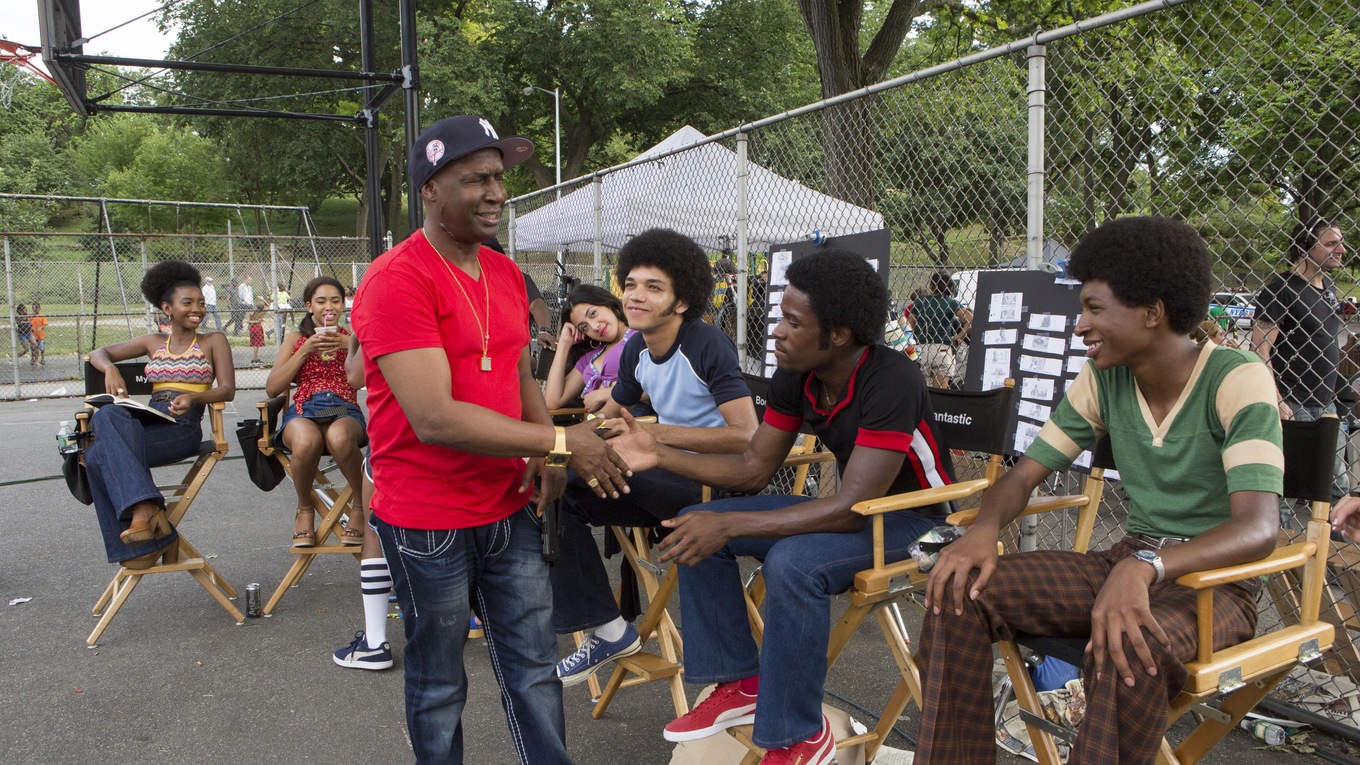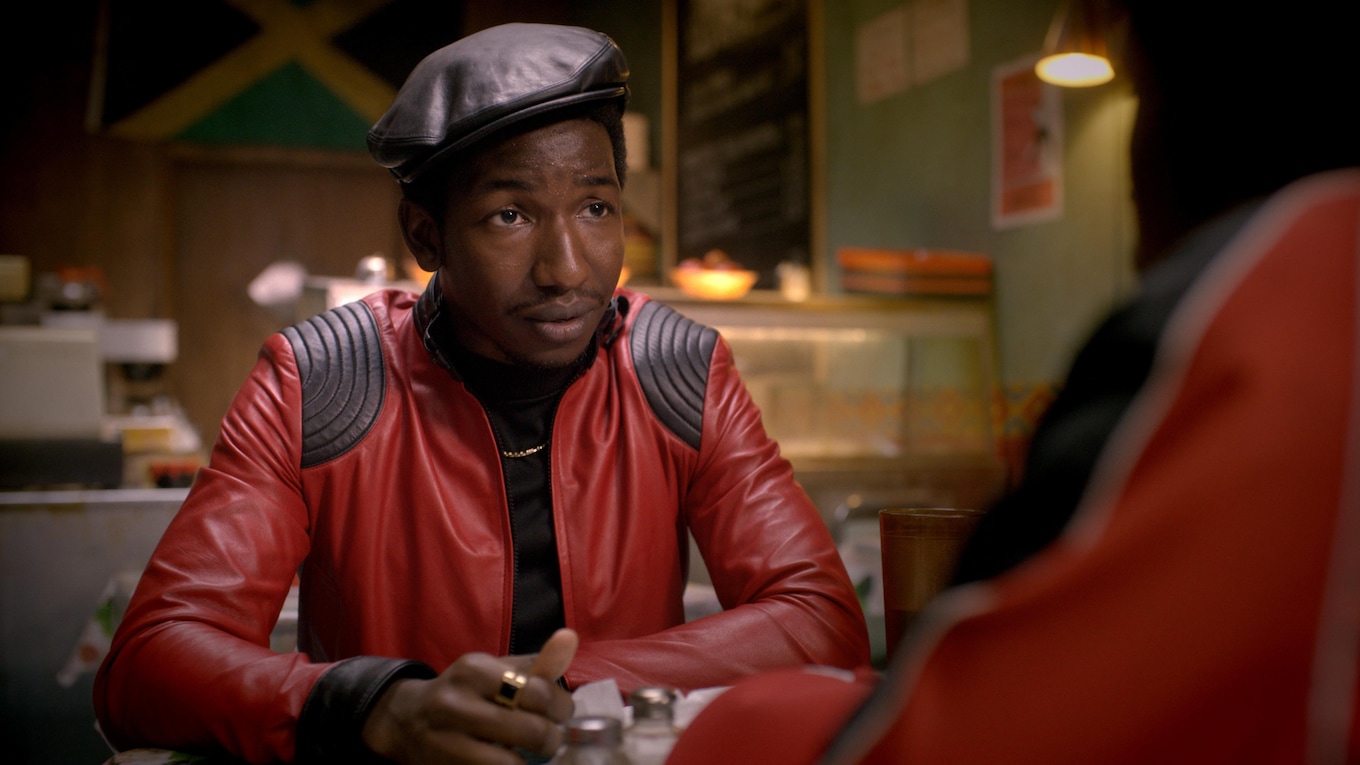There’s a scene in the second episode of Baz Luhrmann’s audacious Netflix hip-hop series The Get Down where graffiti writer, hustler and aspiring DJ Shaolin Fantastic (Shameik Moore) and gifted yet troubled wordsmith Zeke "Books" Figuero (Justice Smith) grapple extensively with the significance of a purple crayon given to them by hip-hop icon Grandmaster Flash (Mamoudou Athie) as they attempt to master the art of DJing. It sets the stage for telling the tale of what Grandmaster Flash, in real life, referred to as the "quick mix theory," a trick that allowed him to repeat the same part of a record in a potentially endless loop on two turntables. It turns out the crayon was used to mark the vinyl so he could calculate a formula on the spinning record.
“4bf = 6rc = loop. The get down part,” Flash tells me over the phone in a recent conversation relaying his shorthand theoretical approach to the turntables. “So for every four bars of music, you have to spin that record six times backwards so we arrive at the top of the break to repeat it. All these are computations that I’ve written down decades ago. But trying to say this 10 years ago, people thought I was some kind of madman. And I’m alright being a madman, it’s OK.”
Back when he developed this approach in the Bronx in the 1970s, where and when The Get Down is set, Flash’s theory often puzzled those he explained it to. “Today, geekism is really cool,” says Flash. “And along with the release of this Netflix series with Baz Luhrmann, now I can mathematically break this thing down scientifically. Because I do it with science and math. Everybody else does it with a groove.”
Along with hip-hop’s founding fathers Kool Herc and Afrika Bambaataa, Grandmaster Flash is one of the three pivotal figures who built the early foundations of hip-hop culture. Flash may have come to worldwide prominence as a member of Grandmaster Flash and the Furious Five through hits like 1982's “The Message” and 1983's “White Lines,” but the group’s recordings, overseen by their Sugar Hill label, largely eschewed the role of the DJ, preferring to use live instruments instead, obscuring Flash’s pivotal innovations in the genre.
However, Flash was responsible for elevating the break technique initiated by Kool Herc to another level with his slick technique and the development of scratching. He also was a pivotal catalyst in the formation of the MC group. As he was too busy cutting and scratching vinyl to talk on the mic like Herc, Coke La Rock and others, he’d leave the microphone available for confident wordsmiths to take up the challenge to move the crowd. The block party scene at the end of the pilot episode depicts an MC who is clearly meant to be Cowboy, a member of Flash’s Furious Five (responsible for the infamous "Throw your hands in the air/And wave 'em like you just don't care" refrain) doing just that so Flash can focus on the wheels of steel. Consequently, in The Get Down, Flash — who served as an associate producer on the show — was intimately involved to ensure the show went back to the essence of the hip-hop DJ.
"We had no PC, no Mac, no laptop, no MP3s, no downloads, no studio, no sampler, no Twitter, no Facebook, no Instagram, no clubs, no nothing. Just two turntables, two copies of vinyl. A makeshift DJ system with a mixer and the nearest park."
After being recruited by Luhrmann, Flash worked closely with the Moulin Rouge director. “[Baz] sits down and he says, ‘First things first, Flash. I want you to explain the quick mix theory, this DJ technique, because this is the ground floor of this whole thing.’ I’m saying, ‘What do you mean?’ So, he says, ‘Pretend you got a couple of turntables in your hand and just do it.’ And I was doing it, moving my hands clockwise and counter-clockwise and he says, ‘Wait a minute, let me get a piece of paper.’ And he grabbed the piece of paper and I did it on that piece of paper and to this day it’s framed in his office and he says, ‘Flash, this is the beginning, right here.’"
Well, it’s not the exact beginning. There is widespread agreement the first hip-hop party demonstrating the break technique was attributed to DJ Kool Herc (portrayed by Eric D. Hill Jr. in the series) at 1520 Sedgwick Avenue in the Bronx. But it's easy to see how Luhrmann could have used the quick mix theory as a template and model for what he puts on the screen. In the frenetically-paced pilot and opening statement, The Get Down traffics in a dizzying mix of visually arresting styles and bricolage. It blends a focus on youthful melodrama, martial arts and superhero motifs while focusing on the creativity and resilience of people in the economically neglected environment of the South Bronx of the 1970s. The pace of the show notably calms in the subsequent five episodes, with other directors devoting extended sequences to the music, like the one featuring the purple crayon.
Flash sees the existence of the show as beneficial to a generation that may not have all the information about the origin of a genre that dominates popular culture over 40 years after its inception. “With hip-hop, chronologically speaking, there was always a blur,” says Flash. “Where did this thing come from?” He believes the show being delivered via Netflix can help bridge the generation gap. “These kids should know how this thing started and what we started with. It’s extremely important,” he says.
“You’ve got to think of it like this: Today you have all these wonderful devices. For us, we didn’t have none of those things. We had no PC, no Mac, no laptop, no MP3s, no downloads, no studio, no sampler, no Twitter, no Facebook, no Instagram, no clubs, no nothing. Just two turntables, two copies of vinyl. A makeshift DJ system with a mixer and the nearest park. We would put our equipment and our crates of records in shopping carts that we would get from the neighbourhood shopping market and roll those to the nearest park and I would break into the lamp post at the bottom, tap my power in and play these things called block parties.”
When Luhrmann decided that Flash needed to be portrayed as a character in the series, Flash initially brushed him off, but when he met Mamoudou Athie, the actor assigned to play him, Flash was taken aback. “[Athie] walked up to me humbly and says, ‘I can only hope that you train me for my part in this series and I really want to make you happy that I’m playing you on this series,’” says Flash. “I think at that point I was quite emotional and I said, ‘Baz, let’s do it!’"
Soon Flash and Athie were rooming together in a house stacked with food and stayed there together for months while Flash trained the actor to DJ. “Back and forth, back and forth and I was 'No! No! No!,'” says Flash, describing how he tutored the actor to assume his skills and demeanour on the turntables. Eventually he was pleased with Athie's prowess. “It was quite wonderful to watch him be me. A pretty cool feeling.”

Stefanée Martin, Herizen F. Guardiola, Grand Master Flash, Shyrley Rodriguez, Justice Smith, Shameik Moore, Skylan Brooks on the set of the Netflix series The Get Down.
In addition to working directly with the actors on the show, Flash worked on the score of The Get Down and sourced his hallowed crates for the incidental music in the show. But it wasn’t only Flash go-to records like Babe Ruth’s “The Mexican” and the Incredible Bongo Band’s “Apache” that were needed. The music had to fit the mood and tone of the scene and Flash worked in close collaboration with executive producer and composer Elliott Wheeler, who worked with Luhrmann in the past on The Great Gatsby. “The love scenes and the violins and a lot of the aggressive beats were from my collection and some of the stuff Elliott would find,” says Flash. “A lot of it was music from my crates.”
Despite the efforts the series has made for authenticity, some have pointed out errors, such as vinyl records from the 1990s appearing in scenes that are set firmly in the 1970s, as well as the omission of various unsung pioneers, among other things. That being said, the show liberally mixes factual and fictional characters and collapses time and space much like every other Luhrmann project. Flash, for his part, defends The Get Down’s creative license.

Mamoudou Athie as Grandmaster Flash in the Netflix series The Get Down.
“We basically were trying to take the pictures and pleasant memories as close as we possibly can,” Flash says. “Anything other than this would have been a documentary, which was not what we were trying to shoot. We wasn’t trying to shoot a documentary, where it was the precise area with the precise people — that’s not what we were trying to do. We were trying to accentuate and sort of glorify incredible moments that the world should know about. So with the content that Baz had and the way he handles the camera, he just made it the only way he knows how to do things, which is in a glorious fashion.”
While the show casts a look back at the inception of a culture and his contributions to it, Flash is clearly grateful for The Get Down bringing the creative energy of his youth and countless others in the Bronx to vivid life in the present day.
“You know, this opens up a very wonderful vault of love,” says Flash. “A labour of love by people like myself, Kool Herc, Afrika Bambaataa, Grand Wizard Theodore, E-Z Mike, DJ Breakout, Disco King Mario. The list goes on and on and on. So many of us, we beat our sound to a different drum. When I decided to make the turntable an instrument is when this thing took off. I didn’t realize this thing was going to be anything, I was just in the moment. I’m in the moment now. I stay in the moment because that’s all we have.”
Follow Del Cowie on Twitter @vibesandstuff
More to explore:
Baz Luhrmann's The Get Down opens 'vault' on hip hop's early days

